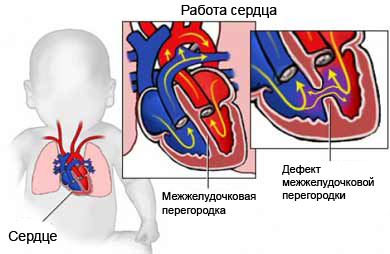Atrial septal defects
Atrial Septal Defect Description
Septal defects – types of congenital heart problems, where there is a hole in the wall, separating the Chambers of the heart. The word “partition” refers to the the wall between the Chambers, and “Congenital” Describes the disease, which is present before birth. Congenital heart disease occurs in 4-12 from 1000 Newborn.
In the normal heart blood flows from the body into the right atrium, comes in right ventricle, and then goes into the lungs, to absorb oxygen. Then the blood returns to the left atrium, enters the left ventricle, and goes to other parts of the body.
When there is a hole in the wall between the atria and ventricles, In this case blood is typically moves from left to right. This leads to, blood, which is already saturated with oxygen is returned to the right heart, and then into the lungs, bypassing the internal organs. As a result,, the heart, and lungs must work harder, than necessary.
There are three main types of septal defect:
- Atrial septal defect (ASD) – opening in the wall between the two upper chambers (the right and left atria) hearts;
- Ventricular septal defect (VSD)- opening in the wall between the two lower chambers (right and left ventricles) hearts;
- Atrioventricular septal defect (ADMP) – the combination of ASD and the interventricular septum, and the anomaly of the tricuspid and mitral heart valves.

Causes of atrial septal defects
In most cases, the cause of the defect is unknown. Nonetheless, in a small number of cases, the reason may be the following:
- Family history of congenital heart disease;
- Viral infection, taking drugs or alcohol during pregnancy.
Risk factors
Since the cause of the disease are largely unknown, there are no known risk factors for this condition.
Symptoms of atrial septal defects
Many people with ASD or VSD disorders do not have symptoms. But, If the hole is large, Symptoms may occur, following . Most people with ADMP have shown symptoms, from infancy:
- Breathlessness;
- Fatigue;
- Poor growth;
- High blood pressure in the lungs and, perhaps, damage to the blood vessels in the lungs;
- Congestive heart failure.
Diagnosis of atrial septal defects
Atrial septal defect is most often suspected, when a doctor hears a heart murmur during a physical examination. This sound is caused by the blood, moving the valve from the heart to the lungs. This sound is generated, because the heart has to pump a very large amount of blood through the valve.
- Echocardiogram – the most common method for, to confirm the diagnosis of atrial septal defect and ADMP. This test can also be used for VSD. An echocardiogram uses high-frequency sound waves (ultrasound), to examine the size and shape of the opening in the partition and cardiac chambers.
Other tests may include:
- Electrocardiogram (ECG) – test, which records the activity of the heart, measuring the electrical current through the heart muscle;
- Chest X-ray – to take a picture of structures in the chest. It may show enlargement of the heart and increased blood flow from the heart to the lungs.
Treatment of atrial septal defects
About 40% All ASD and VSD many disappear in the first year of life. Small defects are closed partitions without treatment.
ASD, that do not close up 2 years, can cause problems in adulthood, therefore often recommended surgery.
Small VSD, that do not close rarely cause problems. Medium and large VSDs may cause problems and need treatment in the first few months of life.
Most children with ADMP are above symptoms and need treatment.
Children with symptoms of congestive heart failure often need to take medication. When septal defect symptoms can not be reduced with medication or the heart continues to pump excess blood, often recommended surgery, to close the opening. When ADMP, usually, need surgery.
For the treatment of septal defect is most often used open-heart surgery. The hole is closed seams or patch, depending on the size and shape of the defect. When ADMP abnormal valves can be restored.
Some atrial septal defects can be closed without surgery by placing a special device in the partition during cardiac catheterization. The device is inserted into the heart through a large vein. Both procedures (surgery and catheterization) They have a very high success rate. Most patients continue to live a normal life, Although a small number of patients have problems and ADMP postoperatively.
Living with atrial septal defect
Some children and adults with septal defect may need antibiotics before certain medical and dental procedures. This is to prevent infection in the heart. If the patient does not need to take antibiotics, you need to ask your doctor, what tests or procedures in the future may require that.
Prevention of atrial septal defects
There are no general guidelines for preventing atrial septal defects.
Atrioventricular septal defect usually occurs in patients with Down syndrome, therefore we developed special programs to help some parents reduce the risk of having a child with the disease.
Women, whose serious health condition or who need to take medication regularly should discuss potential risks with your doctor, before planning a pregnancy.
